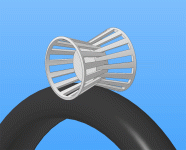GGoodrum
1 MW
rhitee05 said:All I can say is that'll be one heck of a friction drive. Do you plan to try and run it at multi-kW levels, or are you just using that nice motor because you have it lying around?That should really smoke a tire. What would you use as a roller?
Delta-wye is a nice way to get two different ratios without adding any mechanical complexity.
Tires are cheap!
I'm not sure about the roller, but probably one of these:

It is from this site, which somebody posted in one of these friction threads. I actually like this whole kit. I think it could be an inexpensive/simple conversion. Just figure out how to either mount a motor in place of the engine directly, or offset, via a reduction. Hmm... you could take a 3220 with a long 1/2" shaft, and mount it just like the gas engines mount, but you wouldn't have the freewheeling roller. It could do regen, though. :wink: The easiest way to have it freewheel would be to do what Todd is doing, and put a oneway needle bearing in the roller. I'm afraid that might not survive the power levels I'm looking for (3-4kW... maybe more...
I don't need a super-high top-speed, but I'd like it to hit at least 30 mph. What I'm more interested in is low-end torque and quick acceleration.
-- Gary


